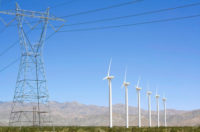The U.S. Energy Dept. provided a pre-Valentine's Day gift to U.S. energy infrastructure construction, announcing nearly $2.7 billion in new and potential funding for added transmission expansion, scaled up geothermal energy systems, first time support of tidal energy projects—and the largest infusion yet for U.S. hydroelectric power system upgrades.
DOE said that large-scale transmission projects can compete for a second solicitation to accelerate buildout of the grid—up to $1.2 billion for capacity contracts that would make the agency an anchor customer for new or upgraded lines.
The anchor contracts are set to shore up investor project confidence by allowing the agency to purchase up to 50% of a line’s transmission capacity for 40 years, DOE said. It also reduces risk of “underbuilding or undersizing” projects. The agency will sell its capacity rights to other customers to recover its costs.
Support for the capacity purchases comes from a $2.5-billion revolving fund established under the 2021 Infrastructure Investment and Jobs Act. It supports upgrades to existing transmission lines and new projects.
Submissions for the first part of the solicitation are due March 11, with the second part not yet released and project winners to be chosen in October.
The U.S. must double regional transmission capacity and expand inter-regional connections by more than five times by 2035 to maintain reliability, improve resilience and relieve congestion, DOE said in a study released last year. The expanded grid also is necessary to accommodate additional clean energy generation.
Three large-scale projects were selected in late October for first solicitation funding totaling $1.3 billion—the $750- million, 500-MW CrossTie project extending 214 miles in Nevada and Utah; the 280-mile high voltage Southline project in Arizona and New Mexico; and the Twin States Clean Energy Link in New Hampshire and Vermont to transport hydroelectric power from Canada.
DOE expects to release a third RFP under the program for public-private partnerships to build transmission that connects isolated microgrids in Alaska, Hawaii and U.S. territories to the grid.
New Focus on Hydro, Tidal Power Projects
In other action, DOE said it selected 46 hydroelectric projects to receive up to $72 million in incentive payments to increase efficiency of plants in 19 states—the agency's largest ever single federal investment in that power sector, funding also earmarked under the federal infrastructure law.
Response to the solicitation has already generated applications requesting $192 million in federal support, DOE said. Funds will boost capital improvement set to increase facility efficiency by 14%, on average, it said, including upgrades to turbines, generators and water conveyance structures.
Hydropower currently accounts for 27% of U.S. renewable electricity generation, as well as 93% of all utility-scale energy storage capacity, DOE said, but selected plants are 75 years old, on average.
Selected projects are located in California, Colorado, Connecticut, Georgia, Idaho, Maine, Massachusetts, New Hampshire, New York, North Carolina, Oklahoma, Oregon, Pennsylvania, Rhode Island, Tennessee, Vermont, Virginia, Washington and West Virginia.
DOE also said it will support development of tidal energy through $16 million in new funding—$6 million for two pilot projects that are developing ocean tidal energy in Maine and Washington state, and about $10 million for a community based river system in Alaska.
These are the first of $35 million in total investment to support projects that can be transitioned to a commercial development. Over the next year the sites will be evaluated for commercial feasibility. DOE will select one project to receive $29 million to test and operate the tidal energy device.
“The projects ... are part of the largest investment by the federal government to advance the technology to capture energy from ocean tides and river currents, while helping decarbonize hard-to-reach coastal communities across the country," said Energy Secretary Jennifer M. Granholm.
Enhanced Geothermal is Hot Stuff
DOE also has earmarked $60 million to fund three western U.S. projects set to boost scalability and cut costs of enhanced geothermal systems (EGS) in the U.S. Others, in the eastern U.S., will be selected in the next funding round. the agency said.
The three projects are: Chevron New Energies, a pilot demonstration that will use innovative drilling and stimulation techniques to access geothermal energy near an existing geothermal field in Sonoma County, Calif.; Fervo Energy, a pilot within the Milford Renewable Energy Corridor in Utah and adjacent to DOE’s geothermal energy field laboratory that aims to produce at least 8 MW of power from each of three wells at a site with no existing commercial geothermal power production; and Mazama Energy, a project on the western flank of Newberry Volcano in Oregon that is set to demonstrate what DOE calls a "first-of-its-kind super-hot" enhanced geothermal system at temperatures above 375°C.
DOE says the latter demonstration "will help advance the science needed to operate in extreme heat conditions."
Geothermal resources currently generate about 4 GW of U.S. power, the agency says, but its recent analysis shows that advancing enhanced geothermal systems could provide 90 GW of flexible power to the grid by 2050—enough to power the equivalent of more than 65 million U.S. homes and support other heating and cooling needs.






